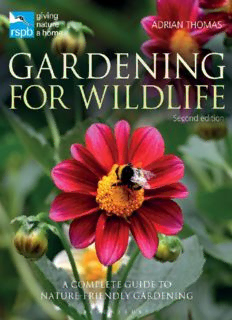
RSPB Gardening for Wildlife, 2nd Edition PDF
Preview RSPB Gardening for Wildlife, 2nd Edition
Contents Foreword by Chris Packham Gardening for Wildlife Why We Should All Garden for Wildlife Myth busting So What is Gardening for Wildlife, then? How Wildlife Sees Gardens In Summary The Right Home for the Right Species Gardening for Birds Gardening for Butterflies Gardening for Mammals Gardening for Reptiles and Amphibians Gardening for Bees Gardening for Dragons and Damsels Gardening for Moths Gardening for Minibeasts Gardening for Mosses and Fungi Creating Different Habitats Making a Woodland Home Making a Scrubland Home Making a Wildflower Meadow Home Making a Cornfield Home Making a Heathland Home Making a Wetland Home Making a Hot-rot Home Gardening for Wildlife in a Large Garden Gardening for Wildlife in a Small Garden Gardening for Wildlife in Pots Low-maintenance Gardening for Wildlife Gardening for Wildlife in the Function Zone Gardening for Wildlife in the Leisure Zone Gardening for Wildlife in the Production Zone Gardening for Wildlife in the Aesthetic Zone Gardening for the Planet The Top 500 Garden Plants for Wildlife Gardening for Wildlife Calendar Measuring Success Acknowledgements Recommended reading Photo credits The RSPB Foreword When it comes to gardening for wildlife, it’s up to you: you can do a little or you can do a lot. But what’s important is to realise that everyone can do something for the wildlife that shares our gardens. And if everyone does their bit to help it really can make a difference. Much of the UK’s wildlife is having a tough time in the so-called ‘countryside’. While conservationists work tirelessly to address conflicts and concerns, you can support their endeavours by trying to improve your own space for as many other species as possible. So many of us in Britain are lucky enough to have access to a garden and these spaces already represent an incredibly valuable refuge, where many plants and animals have successfully adapted to prosper alongside us. It seems only right if we all try to enhance the space we have, to make sure it adds to the health of our world rather than detracting from it. Adrian’s book takes a very realistic, pragmatic and contemporary outlook on gardening for wildlife. This is a modern book for the modern naturalist and gardener, and it is a rich treasury of the information required to succeed in modest or ambitious plans. It provides the biological knowledge you need and sows plenty of original and imaginative ideas. The calendar will keep you on your toes, the myth busting is fabulously reassuring, and the plans for small-scale habitat creation are very tempting and practically simple. Who wouldn’t want to make their very own mini-cornfield? Things might seem rosy in your garden already, but the wild world is a tough place to be, so please use this exciting new book to help conserve as much life as possible, and then you, your friends or family can all enjoy a healthier, wealthier community.
Description: